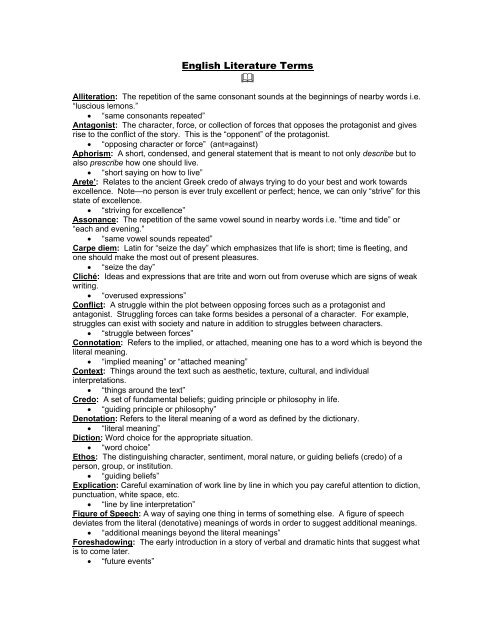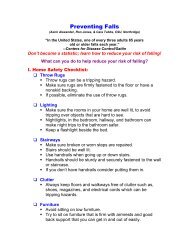English 11-12P: Literature Terms - RonJones.Org
English 11-12P: Literature Terms - RonJones.Org
English 11-12P: Literature Terms - RonJones.Org
Create successful ePaper yourself
Turn your PDF publications into a flip-book with our unique Google optimized e-Paper software.
<strong>English</strong> <strong>Literature</strong> <strong>Terms</strong><br />
�<br />
Alliteration: The repetition of the same consonant sounds at the beginnings of nearby words i.e.<br />
“luscious lemons.”<br />
• “same consonants repeated”<br />
Antagonist: The character, force, or collection of forces that opposes the protagonist and gives<br />
rise to the conflict of the story. This is the “opponent” of the protagonist.<br />
• “opposing character or force” (ant=against)<br />
Aphorism: A short, condensed, and general statement that is meant to not only describe but to<br />
also prescribe how one should live.<br />
• “short saying on how to live”<br />
Arete’: Relates to the ancient Greek credo of always trying to do your best and work towards<br />
excellence. Note—no person is ever truly excellent or perfect; hence, we can only “strive” for this<br />
state of excellence.<br />
• “striving for excellence”<br />
Assonance: The repetition of the same vowel sound in nearby words i.e. “time and tide” or<br />
“each and evening.”<br />
• “same vowel sounds repeated”<br />
Carpe diem: Latin for “seize the day” which emphasizes that life is short; time is fleeting, and<br />
one should make the most out of present pleasures.<br />
• “seize the day”<br />
Cliché: Ideas and expressions that are trite and worn out from overuse which are signs of weak<br />
writing.<br />
• “overused expressions”<br />
Conflict: A struggle within the plot between opposing forces such as a protagonist and<br />
antagonist. Struggling forces can take forms besides a personal of a character. For example,<br />
struggles can exist with society and nature in addition to struggles between characters.<br />
• “struggle between forces”<br />
Connotation: Refers to the implied, or attached, meaning one has to a word which is beyond the<br />
literal meaning.<br />
• “implied meaning” or “attached meaning”<br />
Context: Things around the text such as aesthetic, texture, cultural, and individual<br />
interpretations.<br />
• “things around the text”<br />
Credo: A set of fundamental beliefs; guiding principle or philosophy in life.<br />
• “guiding principle or philosophy”<br />
Denotation: Refers to the literal meaning of a word as defined by the dictionary.<br />
• “literal meaning”<br />
Diction: Word choice for the appropriate situation.<br />
• “word choice”<br />
Ethos: The distinguishing character, sentiment, moral nature, or guiding beliefs (credo) of a<br />
person, group, or institution.<br />
• “guiding beliefs”<br />
Explication: Careful examination of work line by line in which you pay careful attention to diction,<br />
punctuation, white space, etc.<br />
• “line by line interpretation”<br />
Figure of Speech: A way of saying one thing in terms of something else. A figure of speech<br />
deviates from the literal (denotative) meanings of words in order to suggest additional meanings.<br />
• “additional meanings beyond the literal meanings”<br />
Foreshadowing: The early introduction in a story of verbal and dramatic hints that suggest what<br />
is to come later.<br />
• “future events”
Formal Diction: A dignified, impersonal, and elevated use of language that might be hard to<br />
understand—a very controlled language with strict syntactical form and complex words.<br />
• “elevated language” or “difficult to understand language”<br />
Gothic: The dark side of enlightenment related to the things that can’t be explained rationally<br />
through science and reason.<br />
• “dark side of enlightenment”<br />
Grammar: Study or rules of languages and the inflections between words.<br />
• “study or rules of language”<br />
Hubris: The perversion of man’s pride.<br />
• “perverted pride” or “too much pride”<br />
Hyperbole: An extreme overstatement such as “it’s raining cats and dogs.”<br />
• “overstatement”<br />
Informal Diction: A very conversational language to the point where it resembles common<br />
dialogue. If often includes: slang, contractions, and many simple or common words.<br />
• “conversational language”<br />
Irony: A literary device that uses contradictory statements or situations to reveal a reality<br />
different from what appears to be true. The gap between what is expected and what actually<br />
happens in reality.<br />
• “gap between expected and reality”<br />
Jargon: Another form of diction that is related to particular groups in which the language is<br />
defined by a trade or profession.<br />
• “technical language related to a trade or profession”<br />
Logos: Reason that in ancient Greek philosophy is the controlling principle in the universe.<br />
• “logical reason”<br />
Metaphor: A figure of speech that makes an implicit (implied) comparison between two unlike<br />
things without using the words like or as. They assert the identity of dissimilar things such as “all<br />
the world’s a stage.”<br />
• “implicit comparison of unlike things”<br />
Middle Diction: Language that is used by most of the educated people and is fairly conventional<br />
with acceptable patterns of words.<br />
• “educated language”<br />
Motif: A dominate idea, repeated design or color, or central theme. A conspicuous element such<br />
as a type of incident, device, reference, or formula which occurs frequently in works of literature<br />
i.e. the “loathly lady” who turns out to be a beautiful princess is a common motif of folklore.<br />
• “dominate or repeated idea”<br />
Objective: Governed by many people’s opinions.<br />
• “factual and rational viewpoint without personal feelings”<br />
Paraphrase: A restatement of a story’s central ideas in your own words.<br />
• “restatement of central ideas”<br />
Pathos: An emotion of sympathetic pity--suffering, experience, or emotion.<br />
• “sympathetic pity”<br />
Personification: Gives an inanimate object human-like qualities or characteristics.<br />
• “humanizes an object”<br />
Picturesque: Beautiful or striking as in a picture; strikingly graphic and vivid.<br />
• “beautiful and striking”<br />
Plot: Author’s selection and arrangement of incidents in a story. Plot shapes action and gives<br />
the story a particular focus. Plot includes not just what happens but also how and why things<br />
happen the way they do. Plot is the organizing principle that controls the order of events.<br />
• “what, how, and why things happen”<br />
Point of View: Refers to who tells us the story and what their view is of the: plot, characters, and<br />
setting. What we know and what we feel about the story are shaped by the author’s choice of<br />
point of view and their narrator’s point of view.<br />
• “shapes feelings and knowledge of story”<br />
Protagonist: The main character (or force) whom engages the reader’s interest and empathy.<br />
• “main character or force” (pro=for)<br />
2
Satire: Exaggeration and distortion to expose life situations. Satire pokes fun at society through<br />
ridicule, exaggeration, and distortion. It also exposes vices, follies, or errors.<br />
• “exaggeration and distortion”<br />
Setting: The physical and social context in which the action of a story occurs. Major elements<br />
can be: time, place, and social environment. These frame characters and evoke moods that<br />
prepare the reader for what is about to come.<br />
• “physical and social context of story action”<br />
Simile: An explicit comparison between two things by using words such as: like, as, than,<br />
appears, and seems.<br />
• “explicit comparison between two things”<br />
Slang: Type of informal diction used in conversational language that is peculiar to a particular<br />
group.<br />
• “informal and nonstandard language”<br />
Subjective: Governed by one person’s opinion.<br />
• “personal viewpoint”<br />
Sublime: Usually refers to a state of nature that is awe inspiring through sheer terror. A state<br />
that changes ones normal perception of boundaries. There is usually a well-defined boundary<br />
that exists between the “perceived object” and the “perceived subject.” This boundary is eroded<br />
out of necessity when standing next to the sublime in nature—you are forced to interact with the<br />
overpowering force of the sublime.<br />
• “beautiful but scary” or “awe inspiring through sheer terror”<br />
Suspense: “The lack of certainty on the part of a concerned reader about what is going to<br />
happen—especially for characters with whom the reader has established a bond of sympathy.<br />
• “lack of certainty about what will happen”<br />
Symbolism: A person, object, or event that suggests more than its literal meaning. Symbolic<br />
meanings are usually embedded in the texture of a story, but they are not hidden; rather, they are<br />
carefully placed. The reader needs to carefully consider the elements of the story and use<br />
sensitivity to its language along with common sense to recognize symbolism.<br />
• “more than literal meaning”<br />
Syntax: The rules governing word order and word choice. Syntax choice can greatly alter the<br />
feeling of writing.<br />
• “rules for word order and word choice”<br />
Tone: The expression of a literary speaker’s “attitude to the reader.” Expresses a moral<br />
commentary on how the audience is supposed to feel about the action of drama.<br />
• “attitude” or “feeling” of the story<br />
Vanitas Motif: Central idea that one cannot count on anything in life as all life is in a constant<br />
state of flux and change.<br />
• “nothing stays the same”<br />
Zeitgeist: The general intellectual, moral, and cultural climate of an era.<br />
• “spirit of the day”<br />
--Supplemental Sources for Literary <strong>Terms</strong> & Quotations--<br />
A Contemporary Guide to Literary <strong>Terms</strong> by Edwin J. Barton and Glenda A. Hudson.<br />
(Houghton Mifflin Company)<br />
A Glossary Of Literary <strong>Terms</strong> by M. H. Abrams.<br />
(Harcourt Brace Publishers)<br />
A Handbook To <strong>Literature</strong> by William Harmon and C. Hugh Holman.<br />
(Prentice Hall Publishers)<br />
The International Thesaurus of Quotations Compiled by Rhoda Thomas Tripp.<br />
(Perennial Library/Harper & Row Publishers)<br />
The Little Brown Handbook by H. Ramsey Fowler and Jane E. Aaron.<br />
(Harper Collins Publishers)<br />
� www.ronjones.org<br />
3













